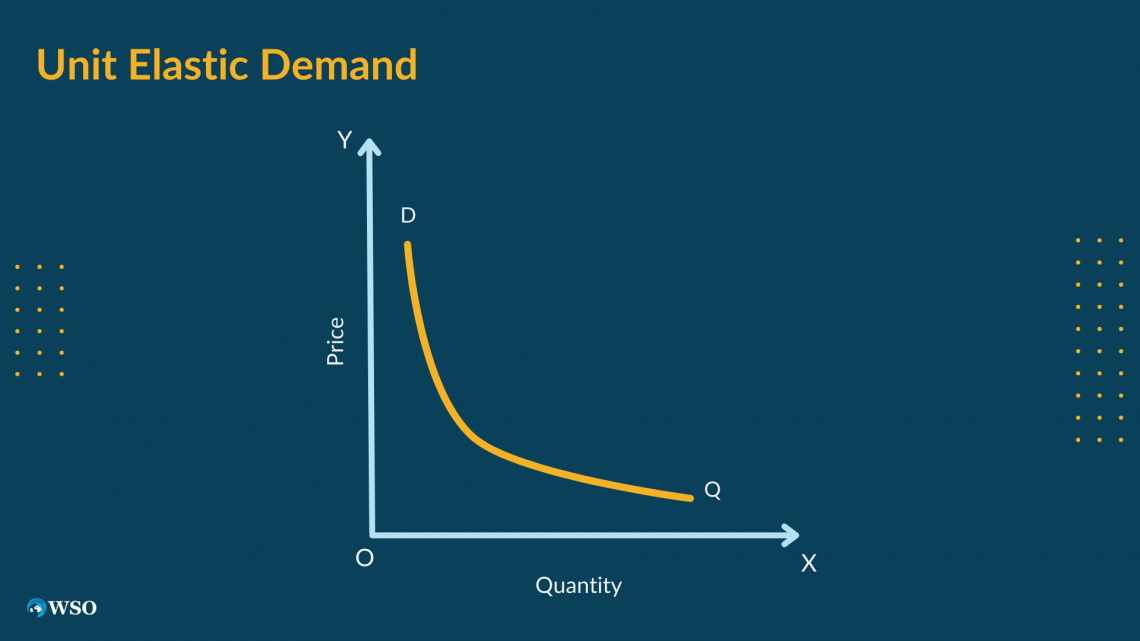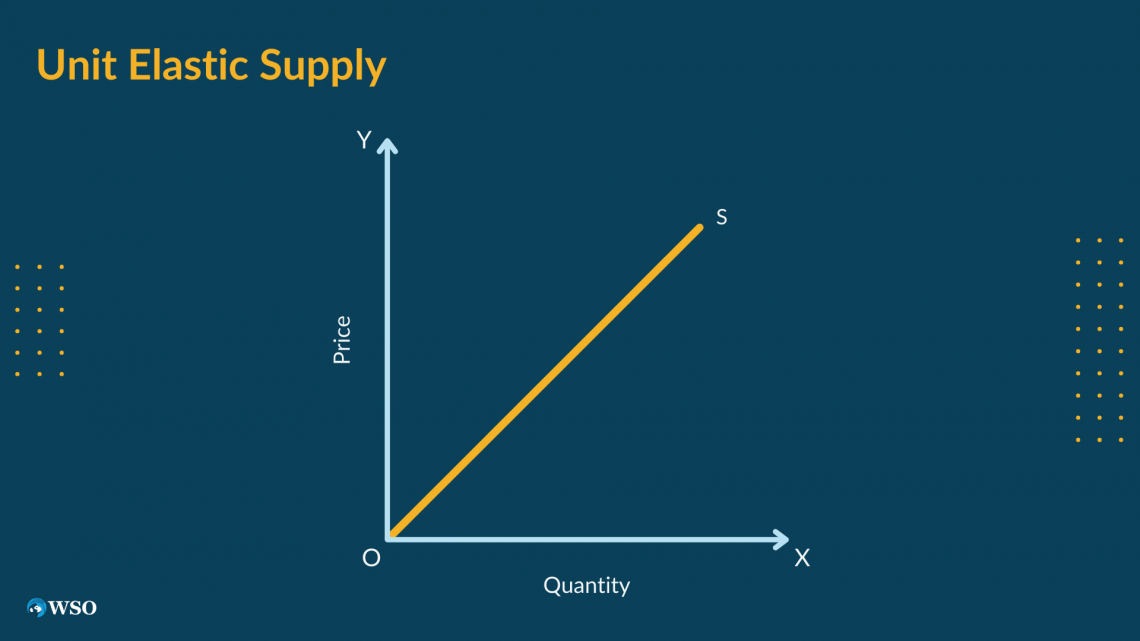Unit Elastic
Refers to a percentage change in price equals a percentage change in the quantity demanded or supplied
What is Unit Elastic?
Unit Elasticity is a term used in economics to describe a situation where a change in the price of a product results in an equal percentage change in the quantity of that product demanded or supplied.

In simpler terms, it means that when the price of a product goes up or down, the amount people want to buy or the quantity a business wants to sell changes by the same percentage.
Price elasticity is used by businesses to determine supply and demand in the dynamic economic market. These steps assist in setting prices, placing orders for goods to satisfy demand, and forecasting profits and losses. Therefore, the demand for goods should fluctuate whenever their price fluctuates.
Under this elasticity, revenue shouldn't change because the percentage change in demand and price are equal. The perfect elastic hypothesis assumes that another comparable good is available at a reasonable cost.
Let's look at an example, imagine a local supermarket that sells apples at $1.40 per pound and makes a monthly profit of $1,400 by selling 1,000 pounds of apples. The owner believes that they can sell more apples if they lower the price, but they don't want to lose their $1,400 profit.
To find out if the demand for apples is unit elastic, the owner decides to reduce the price by 11.43%, selling them for $1.24 per pound. Based on their calculations, this price reduction should result in a similar increase in sales. So, instead of selling 1,000 pounds, they should now sell around 1,114 pounds of apples every month, which is 11.43% more.
In this case, the demand for apples is unit elastic because the percentage change in the price (11.43% decrease) and the percentage change in the quantity demanded (11.43% increase) are equal. The owner can sell more apples without compromising their $1,400 monthly profit.
In practice, finding unit elastic products is difficult. A good is either elastic or inelastic concerning changes in the market.
Key Takeaways
- Unit elasticity denotes a condition in which the percentage change in price matches perfectly to the percentage change in quantity requested or supplied, resulting in an elasticity value of one.
- Price adjustments have no effect on overall revenue in the setting of unit elasticity since every price rise results in an equivalent drop in quantity requested, and vice versa.
- Unit elastic demand shows that customers are generally resistant to price changes, allowing firms to adapt pricing tactics without seeing major revenue shifts.
- Understanding unit elasticity is critical for understanding how customers react to price changes and for developing successful pricing and production strategies.
Unit Elastic Demand
Price elasticity of demand measures the percentage change in demand for a product expressed as a percentage change in the product's price.
With this idea, economists may comprehend how a given product's quantity demanded a response to changes in price. This type of demand elasticity adjusts proportionally to a change in price.
When buyers can find close substitutes for the things that must suit their demands, a unit elastic demand accompanies a price change.
To put it another way, unitary elastic demand suggests that the percentage change in quantity demanded and the percentage change in price are precisely the same.
For a product with such elastic demand, the demand elasticity is 1. Since the demand curve slopes downward, elasticity= -1; nonetheless, elasticity is typically computed as an absolute value.
The product elasticity in a unitary demand is negative since the good's price reduction does not increase revenue. Therefore, the sole change from the previous level is an increase in the volume of goods sold.
The idea of elasticity has potentially significant business ramifications. A firm's pricing strategy must be properly considered if it sells products with unitary elastic demand.
The major justification for this is that a significant price change will cause a significant change in the quantity demanded. Retail consumers' purchasing patterns are not fixed due to their fixed income. The use of those commodities decreases as the prices enter the market.
Nonetheless, it cannot limit the supply of necessities, and even if prices move in the reverse direction, luxury products are unaffected.
Note
It is possible to refrain from consuming things like home appliances and mobile phones. These goods are important to people but not essential for their survival.
Due to the pricing element, the manufacturers of these goods have noticed a trend in their product income. Therefore, producers reduce the selling price of the product and put it on sale to increase their revenue.
Substantial changes in demand can greatly impact the profitability of a corporation.
For instance, if it sells headphones, where demand is elastic at the unit level, a 15% rise in price will result in a 15% drop in demand. As a result, the company's earnings will also drop by 15%.
The perfectly elastic demand curve demonstrates the negative correlation between a product's quantity demanded and its price.
Unitary elastic demand is represented graphically by a rectangular hyperbola.

Because buyers will demand as much of the product as feasible at a price zero, a unit elastic demand curve will be evident. The quantity demanded continues to decline as the price rises. The quantity demanded is the lowest when the price is at its greatest.
Unitary Elastic Demand Advantages
This concept is important for businesses as it can significantly impact revenue and pricing strategies.
The advantages of this elasticity include the following:
1. Price Stability:
Due to price setting, the customer spending pattern does not change.
2. Budget Resilience:
The buyer’s budget did not change in response to the price adjustment, yet this behavior increased or decreased the number of purchased products.
3. Revenue Consistency:
The business has a specific goal for its revenue, unaffected by pricing targets. This means a company can raise or lower prices without significantly impacting its overall sales.
4. Demand Tailoring:
Through the price control mechanism, one can modify the demand that the market creates.
5. Volume Flexibility:
Lowering the selling price can sell any number of manufactured items.
6. Risk Mitigation:
Unit elasticity allows a company to test pricing strategies without incurring significant financial risk.
7. Adaptability:
A company can respond to changes in costs or market conditions without drastically affecting its sales.
8. Sales Forecasting:
It allows businesses to predict how price changes affect their sales, which can be useful in forecasting and budgeting.
Unitary Elastic Demand Disadvantages
Unit elasticity, also known as perfectly elastic demand, occurs when a percentage change in price results in an equal percentage change in the quantity demanded. This means that as the price of goods increases, the quantity demanded decreases by the same percentage.
While perfectly elastic demand can be a useful concept in economics, it has several disadvantages that can impact both consumers and businesses.
1. Immediate Customer Responsiveness:
Consumers in a unit elastic market exhibit rapid responses to changes in pricing. Even slight price adjustments can trigger substantial shifts in demand.
2. Constant Revenue:
When demand is unit elastic, any price increase results in a proportional decrease in the quantity demanded, keeping total revenue relatively constant. Businesses may find it challenging to boost revenue by raising prices, necessitating a focus on product differentiation to increase profit margins.
3. Struggle for Low-Margin Businesses:
Businesses operating on low profit margins face difficulties in sustaining their viability in a unit-elastic market. The need for product expansion often sacrifices these thin margins.
4. Unbalanced Consumer Consumption:
Due to the fixed expenditures associated with products, consumer consumption patterns may become unbalanced in a unit elastic demand environment.
5. Significant Impact on Commodity Demand:
The concept significantly influences the demand for various commodities, particularly those for which consumers have readily available substitutes.
Unit Elastic Supply
A supply that reacts perfectly to changes in price is referred to as a unitary elastic supply. In other words, any variation in the price of a product with unitary elastic supply corresponds to a variation in the quantity supplied that is also proportional.
Unit elastic supply states that if the price fluctuates by 20%, the supply must also vary by 20%. When producers of the supply have easily substitutable goods to manufacture, a unitary elastic supply follows a price change.
For a commodity with unit elastic supply, the supply elasticity is 1. The supply curve is upward-sloping, in contrast to the demand curve. Hence the elasticity of unit elastic supply is just 1.
This is related to the law of supply, which states that if all other factors remain unchanged, the amount of a commodity increases with a price increase. As a result, the graph of unitary elastic supply has an increasing slope.

Because producers are encouraged to offer more of the commodity at a greater price, the unitary elastic supply curve is upward-sloping. Since no supplier is prepared to give away things for free, the graph for unitary elastic supply starts at zero.
Unit elasticity of supply has important repercussions in a business context, much like unit elasticity of demand. For instance, a corporation's production capacities should consider price changes if the firm manufactures commodities with unitary elastic supply. A corporation should adjust its output in response to a large fluctuation in the price of a product.
Unit Elastic Importance
It is an important concept in economics because it helps to understand how price changes will impact the quantity demanded by consumers.
Making intelligent choices about a firm's clientele and the prices associated with goods and services is made easier because of unit elasticity.
Understanding how price changes will impact demand is crucial for businesses as they make decisions about pricing, production, and inventory. Businesses spend much time, effort, and money to comprehend consumer behavior.
Perfectly elastic identifies what corporate leaders should know about the market and how prospective buyers make purchase decisions.
Organizations can use information about this elasticity to assist them in deciding how to set pricing in a way that optimally balances needs and demand by evaluating the data.
Businesses may enhance their decision-making abilities, which are crucial for analyzing the state of the economy, by understanding how to collect and interpret data correctly.
This information is also useful in deciding whether to grow into other countries or regions, what new items customers find appealing, and where to cut particular expenditures.
Furthermore, understanding this concept can help firms and governments design pricing strategies and policies to achieve specific goals, such as revenue maximization, profit maximization, social welfare, and price stabilization.
Unit Elastic FAQs

When a change in price leads to a subsequent proportional change in the quantity demanded, the demand is said to be unit elastic.
Goods like mobile phones and home appliances, which are necessary for people but are not essential for survival, have such an elastic demand. These goods usually have close substitutes. However, in reality, goods are generally either elastic or inelastic.
Alfred Marshall first used the concept of price elasticity of demand in economic theory to describe the degree of responsiveness in demand for a good to a fall in its price.
According to him, “the elasticity (or responsiveness) of demand in a market is great or small as the amount demanded increases much or little for a given fall in price and diminishes much or little for a given rise in price.”



or Want to Sign up with your social account?